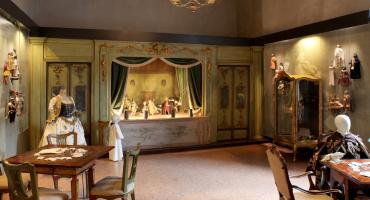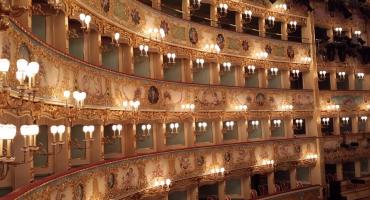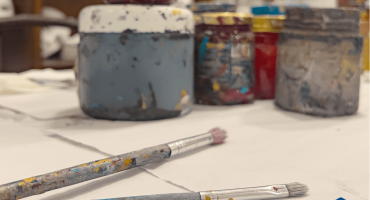In Venetian culture, the term "maschera" didn’t just refer to the classic Carnival disguise—it also described the act of putting on fake beards and mustaches. Moreover, "maschera" became a nickname for women who dressed as men and men who dressed as women.
 The original Venetian masks were rather simple in design and decoration and they often had a symbolic and practical function.
The original Venetian masks were rather simple in design and decoration and they often had a symbolic and practical function.
Masks were often used to protect gamblers from giving away indiscrete looks, especially to avoid their creditors, or by "barnaboti" noblemen who went bankrupt, begging on the corners of the street . Venetian masks were used to hide and protect the wearer's identity during promiscuous or decadent activities, but they became also the symbol of transgression and freedom from the severe social rules imposed by the Serenissima Republic.
The history of mask:
 The mask in the city of Venice has ancient origins and was used for many months of the year. Masks were allowed from the day after Christmas, which marked the beginning of the Venetian Carnival, to Shrove Tuesday which marked its end, but were forbidden during religious celebrations. As well as during the Carnival period, Venetians wore masks during the fortnight of the Ascension, and ended up wearing it, with a few exceptions, half-way through June. During all major events, such as official banquets or other celebrations of the Serenissima Republic, was permitted to wear a mask and a cloak.
The mask in the city of Venice has ancient origins and was used for many months of the year. Masks were allowed from the day after Christmas, which marked the beginning of the Venetian Carnival, to Shrove Tuesday which marked its end, but were forbidden during religious celebrations. As well as during the Carnival period, Venetians wore masks during the fortnight of the Ascension, and ended up wearing it, with a few exceptions, half-way through June. During all major events, such as official banquets or other celebrations of the Serenissima Republic, was permitted to wear a mask and a cloak.
 Codice Bottacin - From the early 14th century, new restrictive laws started to be promulgated by the Venice Government, to stop the relentless moral decline of Venetian people.
Codice Bottacin - From the early 14th century, new restrictive laws started to be promulgated by the Venice Government, to stop the relentless moral decline of Venetian people.
This carnival legislation proscribed masqueraders at night, prevented men from entering convents dressed as women to commit "multas inhonestates" and prevented masqueraders from carrying arms or entering churches. To restore morality in Venice and avoid the incentive of immoral behavior of its citizens, the Serenissima Republic obliged them to wear a mask only during the days of Carnival and at official banquets only.
 Mascarer - Masks were produced for centuries in Venice and were made from papier-mâché, in many different colors and styles and decorated with fur, fabric, gems, or ribbons.
Mascarer - Masks were produced for centuries in Venice and were made from papier-mâché, in many different colors and styles and decorated with fur, fabric, gems, or ribbons.
The use of masks by both Venetians and foreign visitors during Carnival, created a great demand for masks and consequently contributed to the evolution of the figure of the mask-makers, registered artisans who created and sold masks in papier maché.
The traditional Venetian masks:
 Pietro Longhi- Between the most traditional Venetian costumes we find the bauta, a white mask covering almost the whole face, with a black cloak and a cocked hat. This mask was very popular in Venice and was worn both by men and women because it guaranteed total anonymity as it allowed the wearer to eat and drink without having to remove the mask.
Pietro Longhi- Between the most traditional Venetian costumes we find the bauta, a white mask covering almost the whole face, with a black cloak and a cocked hat. This mask was very popular in Venice and was worn both by men and women because it guaranteed total anonymity as it allowed the wearer to eat and drink without having to remove the mask.
 Another traditional mask was the moretta, an oval mask of black velvet with a veil that was usually worn by women visiting convents and was attached to the woman's face thanks to a button held between the teeth.
Another traditional mask was the moretta, an oval mask of black velvet with a veil that was usually worn by women visiting convents and was attached to the woman's face thanks to a button held between the teeth.
 The Mattacino is another typical mask of Venice. He is a sort of clown, dressed in white or multicolored, famous for firing "perfumed eggs" from slingshots to the people who was passing in the street.
The Mattacino is another typical mask of Venice. He is a sort of clown, dressed in white or multicolored, famous for firing "perfumed eggs" from slingshots to the people who was passing in the street.
Masks and Theatre:
But the mask found its official consecration in the theatres: with the 16th century theatre, and later with the most famous Venetian playwright Carlo Goldoni, some of the most popular characters of the commedia dell'arte, the italian popular form of improvisational theater, also called "comedy of humors", became actual stereotypes, perfectly reflecting Venetian society.
Between the primary Commedia dell'Arte characters we find Pantalone, the rich and miserly merchant, Arlecchino, a funny peasant and illiterate character, acrobat and clown, always dressed with a colorful clothing, Colombina, the maidservant and eternal lover of Arlecchino, and Pulcinella, another comic servant character, as Arlecchino, typical of Naples.
 Nowadays:
Nowadays:
Venetian masks re-emerged as the emblem of the Venice Carnival and most of them are made in gesso with a gold leaf and are all hand-painted or decorated with natural feathers and gems. During the modern Carnival Saint Mark's Square and the other main campi of Venice become the perfect stages for those who wish to be, at least for a few hours a year, protagonists of another life. In fact, during the last days of Carnival, Venice teems with people wearing all kind of masks and disguises, happily invading streets and squares in search of fun: it’s possible to meet every kind of costume, from the 18th century noblewomen, to the most inventive and creative personalised modern costumes.
Alongside traditional Venetian masks, we also find the iconic characters of the Commedia dell’Arte, made famous by the theatre and especially by the plays of Carlo Goldoni. Among the most well-known are Pantalone, Arlecchino, Colombina, Brighella, and Pulcinella.
Pantalone. Pantalone is the most famous Venetian mask. His origins are well established: from his first appearance in Commedia dell’Arte troupes, the “first old man,” known as Il Magnifico, spoke in the lively and musical Venetian dialect. That name was soon replaced by the immortal Pantalone. There are several theories about the name’s origin. One links it to San Pantalone, a saint venerated in Venice, with a church dedicated to him. Another suggests it comes from piantaleoni, the merchants who set up shop in conquered lands and symbolically “planted” the lion of Saint Mark, expanding the city’s power through trade. Pantalone is always a merchant—sometimes wealthy and respected, sometimes ruined—but always old. He embodies the mercantile ethics of the Venetian bourgeoisie, which, without noble titles, began to rise among the ruling classes. His costume includes a Greek-style wool cap, a red jacket, short sailor-style trousers, and a belt from which hang a sword, handkerchief, or purse. He wears a black cloak, often lined in red, and black slippers—sometimes Turkish-style with curled toes. His black mask highlights his hooked nose, thick eyebrows, and pointed beard.
Arlecchino. Arlecchino is the most popular mask of the Commedia dell’Arte: silly, gullible, and always hungry. His outfit features a jacket and pants made of colorful, irregular patches, a white felt cap with a rabbit or fox tail, and a belt holding a wooden spatula called batocio, used for stirring polenta. He wears a half-mask with demonic and feline features, sometimes with bushy eyebrows and mustaches. His nose is flat, and he sports a prominent bump on his forehead.
Colombina. Colombina is the cheeky and charming maid of the Commedia dell’Arte. She’s a comic character, not always virtuous, born from the same popular world as Arlecchino—her loyal companion and sometimes heartbroken lover. On stage, she stands out for her wit, flirtatiousness, and cleverness. Her costume is simple, sometimes patchy like Arlecchino’s, finished with a white bonnet and matching apron. She rarely wears a mask and speaks in various dialects, though she prefers Venetian or Tuscan.
Brighella. Brighella is the clever servant of the Commedia dell’Arte, born in the upper part of Bergamo—unlike Arlecchino, the foolish and clumsy servant from the lower part of the city. His name may come from briga or brigare, meaning “to scheme,” which suits his character perfectly. His costume includes a white tunic with green stripes and a green-striped cap. His mask is black or olive green, and he often sports a mustache. A skilled musician, he frequently sings while playing the guitar and speaks in the Bergamasque dialect.
Pulcinella. Pulcinella is the quintessential Neapolitan mask. His facial features resemble a rooster—especially his beak-like nose—which suggests a possible etymology from the dialectal corruption of pullicino, meaning “chick.”
Bibliography: Le Maschere Veneziane, Danilo Reato; Venice: Arsenale Editrice, 1988



